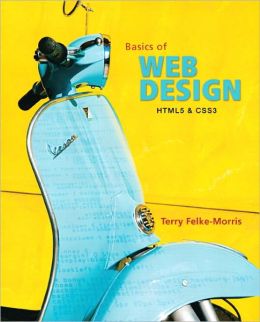Thursday, May 30, 2013
Friday, May 24, 2013
Books on Pessimism
A joke from a Facebook friend:
A man walks Into the library and asks the librarian, "Do you have any books on pessimism?" The librarian responds, "I doubt it."
Do you have any good library jokes?
Thursday, May 23, 2013
Cite Yourself
Faux Pas?
I just finished reading a 5-page article during which the author cites his other work (even a work that is pending publication) 5 times. Is that common practice? Doesn't that amount to an academic pat on the back?
I honestly do not know and would like to learn. Leave me a comment with the answer!
Wednesday, May 22, 2013
Basics of Web Design: Book Review
The Book
Title: Basics of Web Design: HTML5 & CSS3
Author: Terry Felke-Morris
I read this book for the class LIS 5937: Web Design for Librarians. It was a good class though tedious. Web design is about attention to detail while keeping the big picture in mind. This book shows the reader which tools are available to build professional websites out of a simple notepad.
The Review
I particularly enjoyed this book because the text was laid out in a simple, logical manner. This was a book written about the web, but also written like the web. Hence, there were a lot of bullet points, lists and tables that allowed for easy digestion of the material.
In addition, the sections were laid out brilliantly from an editing perspective. As everyone knows, new information is constantly released on this topic, and books must be revised accordingly. The sections stand alone and could easily be removed, rearranged or edited in isolation.
Finally, I found myself using this text as reference material. The index was superb, and I was able to get to all the relevant information for the project at hand with little hindrance.
I wholeheartedly recommend this text to any novice/advanced beginner who needs a little guidance/an offline reference tool for web design. Quite frankly, all of the information in the book can be found online, but sometimes the structure of a book can help beginners get their feet wet.
The Citation
Felke-Morris, T. (2011). Basics of web design: HTML5 and CSS3. Addison-Wesley
Grammar Fail
"...words do not have not fixed boundaries..."
Yes, this was published in a peer-reviewed journal. I understand it, but that language is used solely to try and make this piece a more difficult read.
I will not provide a citation for the protection of those involved.
Monday, May 13, 2013
The Horror!
I Know What I'm Gonna Do This Summer
It's not exactly the stuff of horror movies, but I didn't get into the classes I wanted. Who knew there would be so much competition for Copyright! Here are my courses for the semester, I know they will be beneficial to my career endeavors even if they turn out to be fairly difficult and boring.
My Summer Courses
LIS 6661 Government Documents
LIS 6661 Government Documents
LIS 6726 Indexing/Abstracting
So I will be pressing on. Here's a little factoid that will get me through this year: the last day of classes for my final term is the same as my wife's birthday. Yay!
Friday, May 3, 2013
Collection Management Basics: Book Review
The Book
 |
| Barnes & Noble |
Collection Management Basics (Sixth Edition)
G. Edward Evans
Margaret Zarnosky Saponaro
The Review
For the most part, the readings in this text were assigned in chronological order, so my professor did not feel that the issues present in the Gregory text were founded in this book. Still, this text was relegated as a supplement to our readings from the other textbook, which was the primary text for the class.
The Collection Management Basics has the look and feel of a traditional textbook. It also reads like one, making for dense chapters that approach 30 pages each. As such, this textbook was very informative but not the most pleasant reading material.
The Citation
Evans, G. E., Saponaro, M. Z. Collection management basics. 6th ed. Denver, Colorado: Libraries Unlimited.
Thursday, May 2, 2013
Collection Development and Management: Book Review
The Book
Collection Development and Management for 21st Century Library Collections: An introductionVicki L. Gregory
The Review
My professor decided to begin the course with chapters 4 and 5 of this text before going back to chapters 1-3. Her rationale was that we would need to have some basic knowledge of the Selection (4) and Acquisitions (5) process before assessing the needs of users (2). This makes a great deal of sense. Most textbooks begin by defining crucial terms and then build on the basic concepts, this text assumes that the reader brings a fairly high level of experience with Collection Management (which includes selection) and Acquisitions with them. While I did have a vague sense of what it was, I have a much more solid knowledge of the process now. The difference between collection management and acquisition in the library setting is as follows:
- Collection Management
- The process of selecting materials the library should hold.
- Acquisition
- The physical process involved in actually obtaining the selected materials.
Other than that one issue with the content order, this book was the main text for the course LIS 6511: Collection Development and Maintenance. It was a smooth read and very well supported with documented resources. Chapters hover around 20 pages in length, so they were not too long yet they presented substantial information. This was overall an excellent textbook.
Citation
Gregory, V. L. Collection development and management for 21st century library collections: An introduction. New York: Neal-Schuman.
That Time of the Semester
A Semester Has Ended
Since this semester is basically over, I'm going to have a lot of material to post. I will be posting about my overall experiences with Collection Development and Maintenance and Web Design for Librarians. First, I will review the textbooks that we used in the courses:
- Collection Development and Management for 21st Century Library Collections by Vicki L. Gregory
- Collection Management Basics by G. Edward Evans and Margaret Zarnosky Saponaro
- Basics of Web Design by Terry Felke-Morris
Subscribe to:
Posts (Atom)
© Christopher Jimenez. Powered by Blogger.



